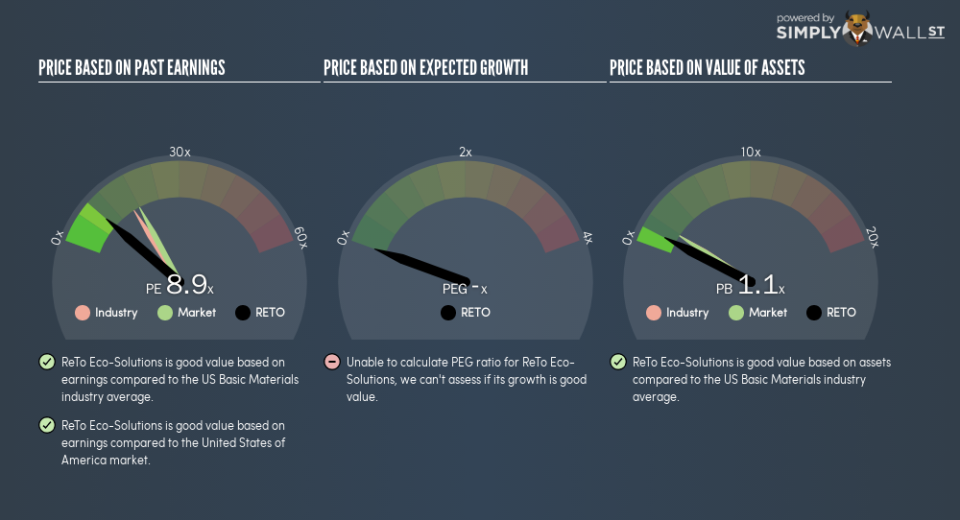Does ReTo Eco-Solutions Inc’s (NASDAQ:RETO) P/E Ratio Signal A Buying Opportunity?

This article is written for those who want to get better at using price to earnings ratios (P/E ratios). We’ll look at ReTo Eco-Solutions Inc’s (NASDAQ:RETO) P/E ratio and reflect on what it tells us about the company’s share price. ReTo Eco-Solutions has a P/E ratio of 8.93, based on the last twelve months. That is equivalent to an earnings yield of about 11%.
Check out our latest analysis for ReTo Eco-Solutions
How Do I Calculate A Price To Earnings Ratio?
The formula for price to earnings is:
Price to Earnings Ratio = Share Price ÷ Earnings per Share (EPS)
Or for ReTo Eco-Solutions:
P/E of 8.93 = $2.33 ÷ $0.26 (Based on the year to June 2018.)
Is A High P/E Ratio Good?
A higher P/E ratio implies that investors pay a higher price for the earning power of the business. All else being equal, it’s better to pay a low price — but as Warren Buffett said, ‘It’s far better to buy a wonderful company at a fair price than a fair company at a wonderful price.’
How Growth Rates Impact P/E Ratios
P/E ratios primarily reflect market expectations around earnings growth rates. When earnings grow, the ‘E’ increases, over time. That means even if the current P/E is high, it will reduce over time if the share price stays flat. So while a stock may look expensive based on past earnings, it could be cheap based on future earnings.
ReTo Eco-Solutions saw earnings per share improve by -8.3% last year.
How Does ReTo Eco-Solutions’s P/E Ratio Compare To Its Peers?
The P/E ratio essentially measures market expectations of a company. We can see in the image below that the average P/E (16.1) for companies in the basic materials industry is higher than ReTo Eco-Solutions’s P/E.
ReTo Eco-Solutions’s P/E tells us that market participants think it will not fare as well as its peers in the same industry. While current expectations are low, the stock could be undervalued if the situation is better than the market assumes. It is arguably worth checking if insiders are buying shares, because that might imply they believe the stock is undervalued.
A Limitation: P/E Ratios Ignore Debt and Cash In The Bank
It’s important to note that the P/E ratio considers the market capitalization, not the enterprise value. Thus, the metric does not reflect cash or debt held by the company. Theoretically, a business can improve its earnings (and produce a lower P/E in the future), by taking on debt (or spending its remaining cash).
Such expenditure might be good or bad, in the long term, but the point here is that the balance sheet is not reflected by this ratio.
How Does ReTo Eco-Solutions’s Debt Impact Its P/E Ratio?
ReTo Eco-Solutions’s net debt is 19% of its market cap. It would probably deserve a higher P/E ratio if it was net cash, since it would have more options for growth.
The Bottom Line On ReTo Eco-Solutions’s P/E Ratio
ReTo Eco-Solutions’s P/E is 8.9 which is below average (17.9) in the US market. The company does have a little debt, and EPS is moving in the right direction. If you believe growth will continue – or even increase – then the low P/E may signify opportunity.
When the market is wrong about a stock, it gives savvy investors an opportunity. If the reality for a company is not as bad as the P/E ratio indicates, then the share price should increase as the market realizes this. Although we don’t have analyst forecasts, shareholders might want to examine this detailed historical graph of earnings, revenue and cash flow.
But note: ReTo Eco-Solutions may not be the best stock to buy. So take a peek at this free list of interesting companies with strong recent earnings growth (and a P/E ratio below 20).
To help readers see past the short term volatility of the financial market, we aim to bring you a long-term focused research analysis purely driven by fundamental data. Note that our analysis does not factor in the latest price-sensitive company announcements.
The author is an independent contributor and at the time of publication had no position in the stocks mentioned. For errors that warrant correction please contact the editor at editorial-team@simplywallst.com.

